-
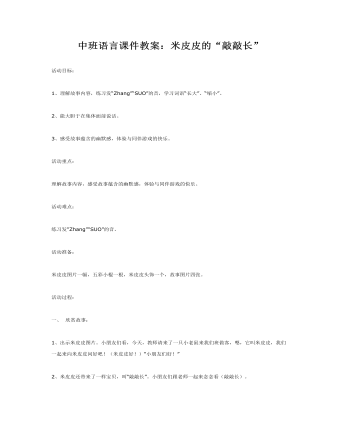
中班语言课件教案:米皮皮的“敲敲长”
2、能大胆于在集体面前说话。3、感受故事蕴含的幽默感,体验与同伴游戏的快乐。活动重点:理解故事内容,感受故事蕴含的幽默感,体验与同伴游戏的快乐。活动难点:练习发“Zhang”“SUO”的音。活动准备:米皮皮图片一幅,五彩小棍一根,米皮皮头饰一个,故事图片四张。活动过程:一、 欣赏故事:1、出示米皮皮图片。小朋友们看,今天,教师请来了一只小老鼠来我们班做客,嗯,它叫米皮皮,我们一起来向米皮皮问好吧!(米皮皮好!)“小朋友们好!”2、米皮皮还带来了一样宝贝,叫“敲敲长”。小朋友们跟老师一起来念念看(敲敲长)。3、米皮皮的敲敲长是一根五颜拥六色很漂亮的小棍,我们就叫它五彩小棍吧!“五彩小棍”我们一起说说看!
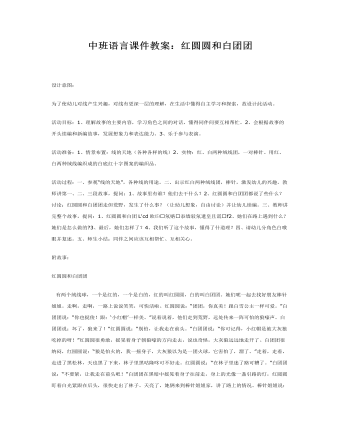
中班语言课件教案:红圆圆和白团团
活动准备:1、情景布置:线的天地(各种各样的线)2、实物:红、白两种绒线团,一对棒针。用红、白两种绒线编织成的白底红十字图案的编织品。活动过程:一、参观“线的天地”,各种线的用途。二、出示红白两种绒线团,棒针,激发幼儿的兴趣。教师讲第一、二、三段故事,提问:1、故事里有谁?他们去干什么?2、红圆圆和白团团都说了些什么?讨论:红圆圆和白团团走但荒野,发生了什么事?(让幼儿想象,自由讨论)并让幼儿续编。三、教师讲完整个故事,提问:1、红圆圆和白团L'cd欧⑸氖赂忝墙驳氖遣皇且谎f2、她们在路上遇到什么?她们是怎么做的?3、最后,她们怎样了?4、我们听了这个故事,懂得了什道理?四、请幼儿分角色白哦眼并复述。五、师生小结:同伴之间应该互相帮忙、互相关心。
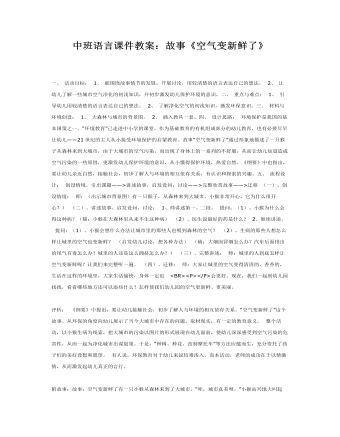
中班语言课件教案:故事《空气变新鲜了》
1、大森林与城市的背景图。 2、插入教具一套。四、设计思路: 环境保护是我国的基本国策之一。“环境教育”已走进中小学的课堂。作为基础教育的有机组成部分的幼儿教育,也有必要尽早让幼儿——21世纪的主人从小接受环境保护的启蒙教育。故事“空气变新鲜了”通过形象地描述了一只猴子从森林来到大城市,由于大城市的空气污染,而出现了身体上的一系列的不舒服,从而让幼儿知道造成空气污染的一些原因,更激发幼儿保护环境的意识,从小懂得保护环境,热爱自然。《纲要》中也指出,要让幼儿亲近自然,接触社会,初步了解人与环境的相互依存关系,有认识和探索的兴趣。五、流程设计: 创设情境,引出课题——>讲述故事,启发设问,讨论——>完整欣赏故事——>迁移 (一)、创设情境: 师:(出示城市背景图)有一只猴子,从森林来到大城市,小猴非常开心,它为什么很开心?) (二)、讲述故事、启发设问、讨论: 1、师讲述第一、二段。 提问:(1)、小猴为什么会得这种病?(辅:小猴在大森林里从来不生这种病) (2)、医生说最好的药是什么? 2、继续讲述。 提问:(1)、小猴会想什么办法让城市里的那些人也吸到森林的空气? (2)、生病的那些人想怎么样让城里的空气也变新鲜? (启发幼儿讨论,想各种办法) (辅:大烟囱冒烟怎么办?汽车后面排出的尾气有毒怎么办?城里的人还是这么拥挤怎么办?) (三)、完整讲述: 师:城里的人到底怎样让空气变新鲜呢?让我们来完整听一遍。 (四)、迁移: 师:大家让城里的空气变得清清的、香香的,生活在这样的环境里,大家生活愉快,身体一定也 会更好。现在,我们一起到幼儿园找找,看看哪些地方还可以添些什么?怎样使我们幼儿园的空气更新鲜、更美丽。
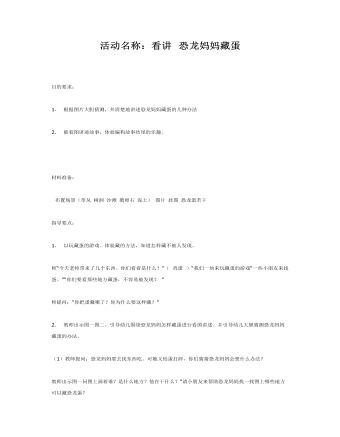
中班语言课件教案:恐龙妈妈藏蛋
2. 能看图讲述故事,体验编构故事结尾的乐趣。材料准备: 布置场景(草丛树洞沙滩鹅卵石泥土)图片挂图恐龙蛋若干指导要点: 1. 以玩藏蛋的游戏。体验藏的方法,知道怎样藏不被人发现。师“今天老师带来了几个东西。你们看看是什么?”(鸡蛋)“我们一块来玩藏蛋的游戏“一些小朋友来找蛋。”“你们要看那些地方藏蛋,不容易被发现? ”师提问:“你把蛋藏哪了?你为什么要这样藏?”2. 教师出示图一图二。引导幼儿围绕恐龙妈妈怎样藏蛋进行看图讲述。并引导幼儿大胆猜测恐龙妈妈藏蛋的办法。
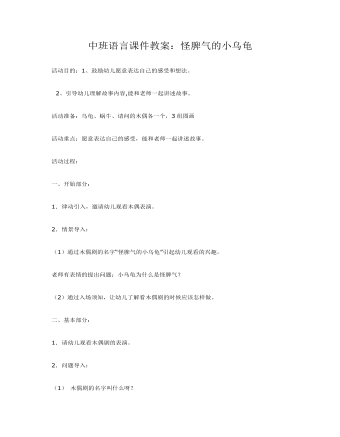
中班语言课件教案:怪脾气的小乌龟
2、引导幼儿理解故事内容,能和老师一起讲述故事。活动准备:乌龟、蜗牛、请问的木偶各一个,3组图画活动重点:愿意表达自己的感受,能和老师一起讲述故事。活动过程:一、开始部分:1. 律动引入,邀请幼儿观看木偶表演。2. 情景导入:(1)通过木偶剧的名字“怪脾气的小乌龟”引起幼儿观看的兴趣。老师有表情的提出问题:小乌龟为什么是怪脾气?(2)通过入场须知,让幼儿了解看木偶剧的时候应该怎样做。

中班语言课件教案:报纸先生的故事
活动准备 1.用纸折成的帽子(帽子上用其他物品装饰好)。 2.布置“娃娃家”背景,有椅子、桌子、垃圾箱等。 3.课前丰富幼儿的知识:报纸与人们生活分不开,是精神食粮。活动过程 一、引入 1.老师戴着用报纸折成的帽子:“小朋友,你们看我今天戴了一项什么?它是用什么做的?” 2.“我有一个故事,是讲报纸先生的,你们想听吗?” 二、老师讲述《报纸先生的故事》(附后),讲完提问: 1.刚才你们听的故事叫什么名字? 2.故事是讲谁的?还有谁? 三、老师再次讲述故事,帮助幼儿初步理解故事的情节和人物的心理变化,知道看过的报纸还可以有很多用途。提问: 1.清晨,报纸先生就被送往谁的家?(理解词语:清晨) 2.报纸先生在信箱里想什么呢?(理解词语:信箱) 3.今天是谁来拿报纸? 4.小红看完报纸后,她把报纸放在哪儿了?(理解词语:丢弃) 5.到了第二天,报纸先生又被送往谁家,这一次是谁来拿呢? 6.奶奶看完报纸后怎么样做呢? 7.奶奶把报纸先生放在一旁,报纸先生怎样想的呢? 8.奶奶会用报纸先生做什么呢? 9.报纸先生为什么会高兴呢? 10.小朋友,你们说报纸先生喜欢谁? 11.报纸先生为什么喜欢奶奶?为什么不喜欢小红? 四、 教师再次讲述故事,并请几名幼儿做情景性表演,加深幼儿对故事的理解。 五、幼儿想想讲讲,发展发散性思维能力,培养节约资源、减少浪费的意识。 1.看过的报纸,还可以做许多事情。如果你是小红,你会用报纸做什么事情呢?请你帮小红想一想。 2.幼儿自由讨论。 3.幼儿讲述报纸的多种用途。
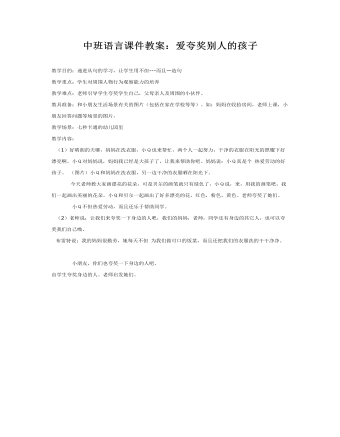
中班语言课件教案:爱夸奖别人的孩子
教学难点:老师引导学生夸奖学生自己,父母亲人及周围的小伙伴。 教具准备:和小朋友生活场景有关的图片(包括在家在学校等等)。如:妈妈在收拾房间,老师上课,小朋友回答问题等场景的图片, 教学场景:七秒卡通的幼儿园里 教学内容: (1)好晴朗的天哪,妈妈在洗衣服,小Q也来帮忙,两个人一起努力,干净的衣服在阳光的照耀下好漂亮啊。小Q对妈妈说,妈妈我已经是大孩子了,让我来帮助你吧。妈妈说:小Q真是个热爱劳动的好孩子。(图片)小Q和妈妈在洗衣服,另一边干净的衣服晒在阳光下。
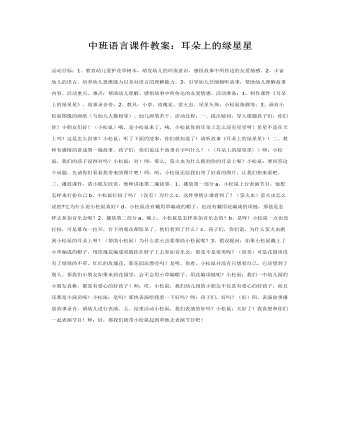
中班语言课件教案:耳朵上的绿星星
活动准备:1、制作课件《耳朵上的绿星星》、故事录音带;2、教具:小草、玫瑰花、萤火虫、星星头饰;小松鼠指偶等;3、画有小松鼠图像的画纸(与幼儿人数相等)、幼儿画笔若干。活动过程:一、提出疑问,导入课题孩子们,你们你!小朋友们好!(小松鼠)哦,是小松鼠来了,咦,小松鼠你的耳朵上怎么还有星星呀?星星不是在天上吗?这是怎么回事?小松鼠:听了下面的故事,你们就知道了!请听故事《耳朵上的绿星星》!二、教师有感情的讲述第一遍故事。孩子们,你们说这个故事名字叫什么?(〈耳朵上的绿星星〉)师:小松鼠,我们的孩子说得对吗?小松鼠:对!师:那么,萤火虫为什么跑到你的耳朵上呢?小松鼠:要回答这个问题,先请你们看看我带来的图片吧!师:哟,小松鼠还给我们带了好看的图片,让我们快来看吧。三、播放课件,请小朋友欣赏,教师讲述第二遍故事。1、播放第一部分a、小松鼠上台表演节目,他想怎样来打扮自己b、小松鼠打扮了吗?(没有)为什么c、这件事情让谁看到了?(萤火虫)萤火虫怎么说的?它为什么说小松鼠真好?d、小松鼠没有戴用草编成的帽子、也没有戴用花编成的项链,那他是怎样去参加音乐会呢?2、播放第二部分a、晚上,小松鼠是怎样参加音乐会的?b、是呀!小松鼠一点也没打扮,可是幕布一拉开,台下的观众都惊呆了,他们看到了什么?
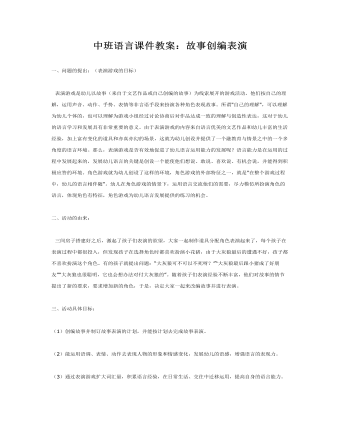
中班语言课件教案:故事创编表演
二、活动的由来: 三间房子搭建好之后,激起了孩子们表演的欲望,大家一起制作道具分配角色表演起来了,每个孩子在表演过程中都很投入,但发现孩子在选择角色时都喜欢扮演小花猪,由于大灰狼最后的遭遇不好,孩子都不喜欢扮演这个角色。有的孩子就提出问题:“大灰狼可不可以不死呀?”“大灰狼最后跟小猪成了好朋友”“大灰狼也很聪明,它也会想办法对付大灰狼的”。随着孩子们表演经验不断丰富,他们对故事的情节提出了新的要求,要求增加新的角色,于是,决定大家一起来改编故事并进行表演。三、活动具体目标:(1)创编故事并制订故事表演的计划,并能按计划去完成故事表演。(2)能运用语调、表情、动作去表现人物的形象和情感变化,发展幼儿的语感,增强语言的表现力。(3)通过表演游戏扩大词汇量,积累语言经验,在日常生活、交往中迁移运用,提高自身的语言能力。(4)培养幼儿自信、勇敢、大方的个性,能积极主动与人交谈、协商、合作与交往。
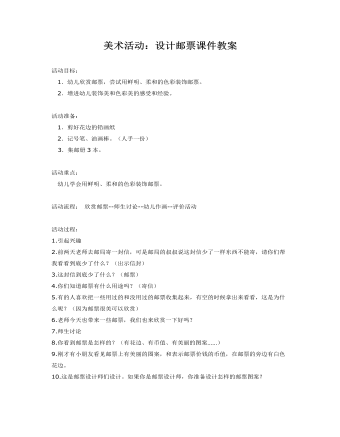
美术活动:设计邮票课件教案
2.增进幼儿装饰美和色彩美的感受和经验。 活动准备:1.剪好花边的铅画纸2.记号笔、油画棒。(人手一份) 3.集邮册3本。活动重点: 幼儿学会用鲜明、柔和的色彩装饰邮票。活动流程:欣赏邮票--师生讨论--幼儿作画--评价活动
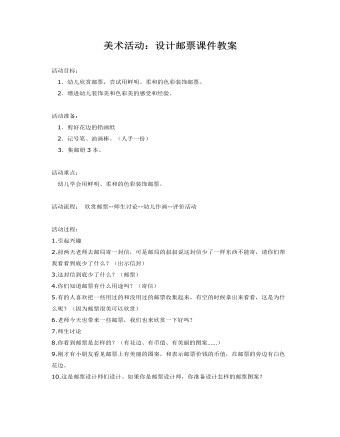
美术活动:设计邮票课件教案
2.增进幼儿装饰美和色彩美的感受和经验。 活动准备:1.剪好花边的铅画纸2.记号笔、油画棒。(人手一份) 3.集邮册3本。活动重点: 幼儿学会用鲜明、柔和的色彩装饰邮票。活动流程:欣赏邮票--师生讨论--幼儿作画--评价活动
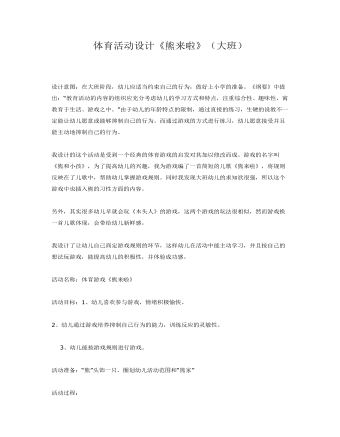
体育活动设计《熊来啦》课件教案
我设计的这个活动是受到一个经典的体育游戏的启发对其加以修改而成。游戏的名字叫《熊和小孩》,为了提高幼儿的兴趣,我为游戏编了一首简短的儿歌《熊来啦》,将规则反映在了儿歌中,帮助幼儿掌握游戏规则。同时我发现大班幼儿的求知欲很强,所以这个游戏中也插入熊的习性方面的内容。另外,其实很多幼儿早就会玩《木头人》的游戏,这两个游戏的玩法很相似,然而游戏换一首儿歌体现,会带给幼儿新鲜感。我设计了让幼儿自己商定游戏规则的环节,这样幼儿在活动中能主动学习,并且按自己的想法玩游戏,能提高幼儿的积极性,并体验成功感。活动名称:体育游戏《熊来啦》活动目标:1、幼儿喜欢参与游戏,情绪积极愉快。2、幼儿通过游戏培养抑制自己行为的能力,训练反应的灵敏性。 3、幼儿能按游戏规则进行游戏。活动准备:“熊”头饰一只,圈划幼儿活动范围和“熊家”活动过程:1、导入活动。 教师:“如果你突然遇到一头大狗熊,你该怎么样,它才不会吃你?”幼儿讨论提出意见。

新人教版高中英语必修3Unit 1 Festivals and Celebrations-Listening &Speaking&Talking教学设计
The theme of this section is “Talk about festival activities and festival experiences”.Festival and holiday is a relaxing and interesting topic for students. This part talks about the topic from the daily life of students’. In the part A ---Listening and Speaking, there are three conversations among different speakers from three countries(Japan, Rio and China), where the speakers are participating in or going to participate in the festivals and celebrations. So listening for the relationship among them is a fundamental task. Actually, with the globalization and more international communication, it is normal for Chinese or foreigners to witness different festivals and celebrations in or out of China. In the Conversation 1, a foreign reporter is interviewing a Japanese young girl who just had participated in the ceremony of the Coming-of-Age Day on the street and asking her feeling about the ceremony and the afterwards activities. Conversation 2, Chinese girl Li Mei is witnessing the Rio Carnival for the first time, and her friend Carla gives her some advice on the costumes which enables her to match with the carnival to have a good time. Conversation 3, a Chinese guide is showing a group of foreign visitors around the Lantern Festival and introducing the customs of the festival to them. The three conversations have a strong vitality and insert the festival and cultural elements from different countries. So perceiving the festivals and cultures from different countries is the second task. At the same time, the scripts also insert the targeted grammar --- v-ing as attributive and predicative, which students can perceive and experience in a real context and make a road for the further study. That is the third task. In the Part B--- Listening and Talking, the theme is “Talk about festival experience”, which is the common topic in our daily conversations. During the conversation, Song Lin, a Chinese student, asked Canadian friend Max about how to spend Christmas. In the conversation, Song Lin talked about experience and the feelings during the Chinese Spring Festival, during which there are not only some enjoyable things but some unpleasant things. After the listening, perhaps students find there are some similarities between Christmas and the Chinese Spring Festival as there are some differences in the origins and celebrations. For example, people always visit friends and relatives, decorate their houses, have a big dinner together, chat and give presents to each other.

新人教版高中英语必修3Unit 1 Festivals and Celebrations-Reading for Writing教学设计一
The topic of this part is “Write about your festival experience”.During the Listening and Speaking and Talking, students are just asked to say out their festival experiences such as the Spring Festival, Mid-autumn Day, but this part students will be asked to write down their own festival experiences. During the reading part, it introduces the Naadam Festival in Inner Mongolia Autonomous Region, which can give students a good example to imitate. Students not only learn the festival, but touch and feel the Inner Mongolian’s character, the spirit and cultural atmosphere, which can help students form the cultural awareness and learn to enjoy and value the diversity of Chinese culture.Concretely, the dairy tells the experience that the author spent the Naadam Festival in Inner Mongolia Autonomous Region with his/her friend. The structure is clear. In the opening paragraph, it introduces the topic of the Naadam Festival and the whole feeling. Then it introduces the items of the festival like the ceremony, wrestling and horse racing. Finally, it summarizes this experience. Because this part is a travel journal, we must guide students pay more attention to these details: 1. use the first person. 2. use the past tense to tell the past thing and use the present or future tense to describe the scenery. 3. use the timeline to tell the development. 4. be careful for the author’s psychology, emotion and feeling, etc.1. Read quickly to get main idea; read carefully to get the detailed information about Naadam Festival.2. Learn the structure of the reading article and language.3. Write an article about a festival experience4. Learn to use the psychology, emotions and feeling in the writing.1. Write an article about a festival experience.2. Use the structure of the reading article and language.

新人教版高中英语必修3Unit 2 Morals and Virtues-Discovering Useful Structure教学设计
1. 表示时间。Hearing these stories, I’m skeptical about the place. = When I heard these stories. . . 2. 表示原因。Not knowing his address, I can’t send this book to him. = Because/Since/As I don’t know his address. . . 3. 表示结果。His father died, leaving him a lot of money. =. . . and left him a lot of money4. 表示条件。Going straight down the road, you will find the department store. = If you go straight down the road. . . 5. 表示让步。Being tired, they went on working. =Although they were tired. . . 6. 表示行为方式、伴随情况或补充说明。He lay on the grass, staring at the sky for a long time. =. . . and stared at the sky for a long time注意:非谓语动词作状语时, 如所提供的动词不能和句子中的主语保持一致, 动词-ing形式必须有自己的逻辑主语, 通常由名词或代词来担任, 这就是独立主格结构。The last bus having gone, we had to walk home. (having gone的逻辑主语是the last bus, 而不是we)Weather permitting, the football match will be played on Friday. (permitting的逻辑主语是time, 而不是the football match)Step 7 Practice1. ________(study) hard, you are sure to get first prize. 2. People use plastic in their daily life, _______(leave) large amounts of waste. 3. ________(work) hard at your lessons, you are to succeed. 4. The old man, ____________(work) abroad for twenty years, is on the way back to his motherland. 5. ______________(finish) his homework, he was playing on the playground. Answers: 1. Studying 2. leaving 3. Working 4.having worked 5. Having finishedStep 8 HomeworkFinish the homework on Page 22.
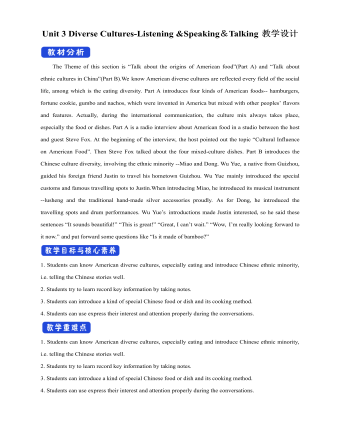
新人教版高中英语必修3Unit 3 Diverse Cultures-Listening &Speaking&Talking教学设计
1. In Picture 1 and Picture 2, where do you think they are from? How do you know?From their wearings, we can know they are from ethnic minority of China--- Miao and Dong.Picture 1, they are playing their traditional instrument lusheng in their traditional costumes.Picture 2. the girls are Miao because they wear their traditional costumes and silver accessory.2. In Picture 3, can you find which village it is? What time is it in the picture?It is Dong village. It is at night. Step 2 While-listeningJustin met a new friend while traveling in Guizhou. Listen to their conversation and complete the summaries below.Part 1Justin and Wu Yue watched some Miao people play the lusheng. The instrument has a history of over 3,000 years and it is even mentioned in the oldest collection of Chinese poetry. Then they watched the lusheng dance. Justin wanted to buy some hand-made silver/traditional accessories as souvenirs. He was told that the price will depend on the percentage of silver. Part 2They will go to a pretty Dong minority village called Zhaoxing. they will see the drum towers and the wind and rain bridges. They may also see a performance of the Grand Song of the Dong people.Step 3 Post-listening---TalkingWork in groups. Imagine Justin is telling some friends about his trip to Guizhou. One of you is Justin and the rest of you are his friends. Ask Justin questions about his trip and experience. The following expressions may help you.
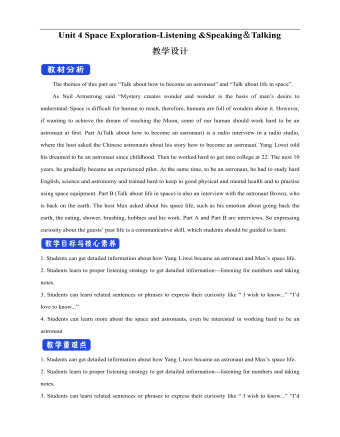
新人教版高中英语必修3Unit 4 Space Exploration-Listening&Speaking&Talking教学设计二
The themes of this part are “Talk about how to become an astronaut” and “Talk about life in space”. As Neil Armstrong said “Mystery creates wonder and wonder is the basis of man’s desire to understand. Space is difficult for human to reach, therefore, humans are full of wonders about it. However, if wanting to achieve the dream of reaching the Moon, some of our human should work hard to be an astronaut at first. Part A(Talk about how to become an astronaut) is a radio interview in a radio studio, where the host asked the Chinese astronauts about his story how to become an astronaut. Yang Liwei told his dreamed to be an astronaut since childhood. Then he worked hard to get into college at 22. The next 10 years, he gradually became an experienced pilot. At the same time, to be an astronaut, he had to study hard English, science and astronomy and trained hard to keep in good physical and mental health and to practise using space equipment. Part B (Talk about life in space) is also an interview with the astronaut Brown, who is back on the earth. The host Max asked about his space life, such as his emotion about going back the earth, the eating, shower, brushing, hobbies and his work. Part A and Part B are interviews. So expressing curiosity about the guests’ past life is a communicative skill, which students should be guided to learn.1. Students can get detailed information about how Yang Liwei became an astronaut and Max’s space life.2. Students learn to proper listening strategy to get detailed information---listening for numbers and taking notes.3. Students can learn related sentences or phrases to express their curiosity like “ I wish to know...” “I’d love to know...”4. Students can learn more about the space and astronauts, even be interested in working hard to be an astronaut
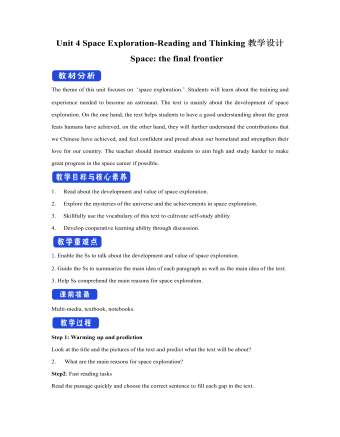
新人教版高中英语必修3Unit 4 Space Exploration-Reading and Thinking教学设计二
The theme of this unit focuses on “space exploration.” Students will learn about the training and experience needed to become an astronaut. The text is mainly about the development of space exploration. On the one hand, the text helps students to have a good understanding about the great feats humans have achieved, on the other hand, they will further understand the contributions that we Chinese have achieved, and feel confident and proud about our homeland and strengthen their love for our country. The teacher should instruct students to aim high and study harder to make great progress in the space career if possible.1. Read about the development and value of space exploration.2. Explore the mysteries of the universe and the achievements in space exploration.3. Skillfully use the vocabulary of this text to cultivate self-study ability 4. Develop cooperative learning ability through discussion.1. Enable the Ss to talk about the development and value of space exploration.2. Guide the Ss to summarize the main idea of each paragraph as well as the main idea of the text.3. Help Ss comprehend the main reasons for space exploration. Multi-media, textbook, notebooks.Step 1: Warming up and predictionLook at the title and the pictures of the text and predict what the text will be about?2. What are the main reasons for space exploration?
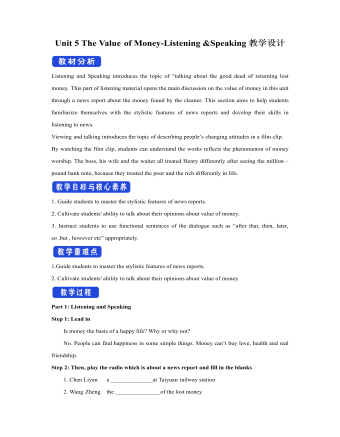
新人教版高中英语必修3Unit 5 The Value of Money-Listening &Speaking教学设计
Step 4: Listen again and decide if the following statements are true (T) or false (F).1 It was the first time Chen Liyan's story was reported. T口 F口2 Chen found 10,000 yuan in a small plastic bag in Taiyuan railway station口 F口3 Wang Zheng apologized to Chen because he couldn't offer her more money. T口 F口4 Chen took out a large loan to cure her daughter, T口 F口5 Wang set up a fundraising website for Chen's daughter after Chen told him about her situation. T口 F口Step 5:After listening, discuss the questions.1 What kind of person do you think Chen Liyan is?Chen Liyan is generous and honest because she returned a large sum of money to the owner.2 Did Chen return the money because she didn't need it?No. She returned the money because it was the right thing to do. Evidence for this is that she refused to accept the reward money because she felt that it had not been earned. 3 Is it common for people to do what Chen did?It depends on the culture. In some countries it is quite common to return money that has been found. In other countries, people believe "Finders are keepers!" 4 How did Wang Zheng feel about the return of his money?He must have been very happy and relieved to have gotten his money back. We know this because he thanked Chen repeatedly and even offered her a reward.5 Why did Ma Dongbao tell Wang about Chen's family?He must have had great sympathy for Chen and her daughter and wanted to help them.'We know this because he arranged help for them. 6 How did the news reporter feel about Chen's actions?The news reporter felt that it showed that money wasn't the most important thing in life. We know this because the reporter told us that this is what Chen believes. and then said, “that's a great attitude to take."
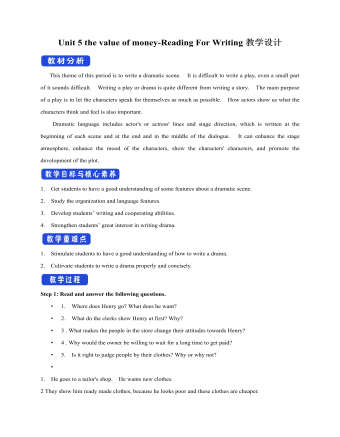
新人教版高中英语必修3Unit 5 the value of money-Reading For Writing教学设计一
【参考范文】Narrator:(Henry is smiling as he leaves the restaurant. As he is walking down the street, he sees a sign for a place that cuts hair. He decides to get it cut. )H=Henry;B=Barber;R=rude manH:Good afternoon, I'd like to get a cut, if I may. (The barber looks at Henry's hair and continues cutting another man's hair. )Er, I'd really like a haircut. As you can see it's much too long. B:(in a rude manner) Yes, I can see that. Indeed, I can. H:Fine, well I'll have a seat then. (He sits in one of the barber's chairs. The barber turns to look at Henry. )B:It's quite expensive here, you know!Are you sure you can afford it?H:Yes. I think so. (In comes the rude man. )R:Hey you there. I need a haircut quickly. Can you do me straightaway?B:All right, then, get in the chair and I'll see what I can do. R:Thank you. (sits down in one of the barber's chairs)H:Excuse me, but I was here first. Aren't you going to do my hair first?B:This man's in a hurry. H:Well so am I!I insist that you cut my hair first. B:OK, but I'll have to be quick. This gentleman is waiting. H:Thank you. (They both become quiet. After his hair is cut, the barber tells Henry how much he must pay. Henry shows the barber the bank note. )B:Why, Mr . . . (looks shocked)H:Adams. Henry Adams. I'm sorry, I don't have any change. R:You're that Mr Adams! Well,I'm glad I waited or I might never have known it was you. B:Why, Mr Adams, please don't worry!(wearing a big smile) Nothing to worry about!Nothing at all!Please come back any time, even if you only need too little hairs cut!It will be my honour to serve you!